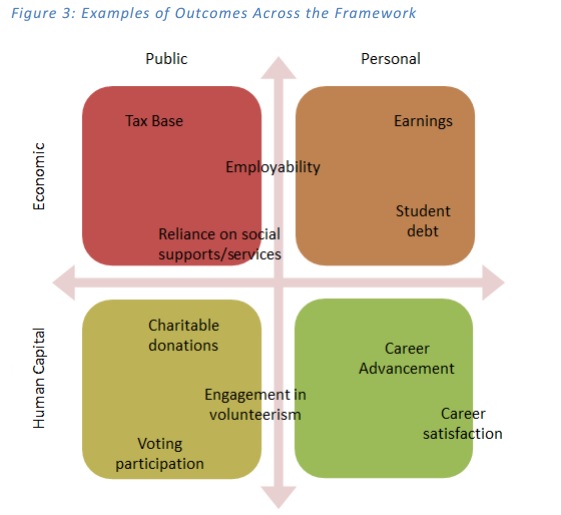You have /5 articles left.
Sign up for a free account or log in.
WASHINGTON -- Lawmakers will continue to look for ways to measure the value of a college degree. Acknowledging this, a group of three higher education associations say they want to help that conversation be more informed and comprehensive.
The groups, which represent the various sectors of public higher education, on Thursday released a draft discussion guide for how to track what happens to students after college.
The Post-College Outcomes Framework and Toolkit is from the American Association of Community Colleges (AACC), the Association of Public and Land-grant Universities (APLU) and the American Association of State Colleges and Universities (AASCU). The Bill & Melinda Gates Foundation funded the project.
The three groups did not suggest specific metrics. That might come later, officials said. But in the meantime, the framework attempts to lay out which areas matter most in determining what students get out of attending college.
“This is really about expanding the conversation,” said Christine Keller, vice president of research and policy analysis for the land-grant association, “to help people think about the benefits of higher education.”
Keller and others spoke here at an event to unveil the project. A key goal, they said, was to encourage policy makers to use appropriate measures of post-college success, rather than just available or simple ones. Although the participants did not single out politicians' initiatives -- such as the Obama administration's pending rating system, and recent legislative proposals -- the associations' project clearly seems designed both as a counterpoint and as an attempt to expand on those efforts.
The framework starts by breaking student outcomes into the public -- meaning how individuals interact with society, such as their impact on the economy -- and the personal. It also factors in the economic and “human capital” values of a higher education. The overview released Thursday included several types of results that could be measured under this approach, such as personal earnings, student debt, voting participation, career satisfaction and public tax revenues (see chart).

“A postsecondary education is woven into all aspects of community and economy,” Kent Phillippe, a senior research associate at AACC who is leading the project, said in a written statement. “Assigning value to an institutional experience or credential can be a challenge, and existing approaches too often default to measures of employment and earnings that fail to capture the broader contribution of college attendance to an individual.”
Robert Kelchen is an assistant professor of education at Seton Hall University who has worked on college ratings systems. He applauded the tone of the framework.
“I’m glad to see colleges recognizing the need to demonstrate value to students in the families,” he said in an email, “both through short-term outcomes such as employment and earnings that get a lot of attention and through longer-term outcomes such as civic engagement.”
Kelchen said measures with a longer horizon, such as voting rates of graduates a decade after they leave college, are clearly valuable. However, those indicators would show little about what institutions are doing for today’s students.
“It is unlikely that the long-term outcomes proposed will be strongly considered by policymakers looking to develop an accountability system,” he said.
The three associations typically have tried to stay ahead of policy pushes to hold colleges accountable for how students fare in the job market. And some of their peers in the higher education lobby have been more aggressive in fighting off those efforts.
For example, APLU last year proposed an alternative to President Obama’s plan for rating colleges, which was still taking shape at the time.
The final ratings proposal from the White House included several of the group’s suggestions. It also cited the Student Achievement Measure (SAM) as a possible future inclusion. That measure, which six of the major higher-education associations created, tracks undergraduate student progress and completion across institutions. (Note: This paragraph has been changed from a previous version to correct an erroneous reference to the Student Achievement Measure.)
The new framework builds on several previous voluntary efforts from the three groups, including SAM and the community college group’s Voluntary Framework of Accountability (VFA). By combining them, the associations said they have taken a first step toward the “creation of common metrics and indicators for reporting a more comprehensive set of post-collegiate outcomes.”




